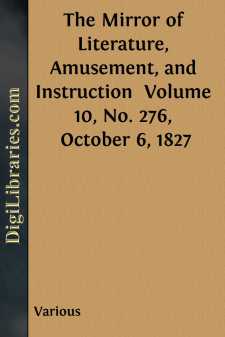Categories
- Antiques & Collectibles 13
- Architecture 36
- Art 48
- Bibles 22
- Biography & Autobiography 813
- Body, Mind & Spirit 142
- Business & Economics 28
- Children's Books 14
- Children's Fiction 11
- Computers 4
- Cooking 94
- Crafts & Hobbies 4
- Drama 346
- Education 46
- Family & Relationships 57
- Fiction 11829
- Games 19
- Gardening 17
- Health & Fitness 34
- History 1377
- House & Home 1
- Humor 147
- Juvenile Fiction 1873
- Juvenile Nonfiction 202
- Language Arts & Disciplines 88
- Law 16
- Literary Collections 686
- Literary Criticism 179
- Mathematics 13
- Medical 41
- Music 40
- Nature 179
- Non-Classifiable 1768
- Performing Arts 7
- Periodicals 1453
- Philosophy 64
- Photography 2
- Poetry 896
- Political Science 203
- Psychology 42
- Reference 154
- Religion 513
- Science 126
- Self-Help 84
- Social Science 81
- Sports & Recreation 34
- Study Aids 3
- Technology & Engineering 59
- Transportation 23
- Travel 463
- True Crime 29
The Mirror of Literature, Amusement, and Instruction Volume 10, No. 276, October 6, 1827
by: Various
Categories:
Description:
Excerpt
BRISTOL CATHEDRAL.
There is given
Unto the things of earth, which Time hath bent,
A spirit's feelings, and where he hath leant
His hand, but broke his scythe, there is a power
And magic in the ruin'd battlement
For which the palace of the present hour
Must yield its pomp, and wait till ages are its dower.
BYRON.
The cathedral of Bristol is one of the most interesting relics of monastic splendour which have been spared from the wrecks of desolation and decay. It is dedicated to the holy and undivided Trinity, and is the remains of an abbey or monastery of great magnificence, which was dedicated to St. Augustine. The erection of this monastery was begun in 1140, and was finished and dedicated in 1148, according to the inscription on the tomb of the founder, Robert Fitzharding, the first lord of Berkeley, who, together with others of that illustrious family, are enshrined within these walls. It was also denominated the monastery of the black regular canons of the order of Saint Victor, who are mentioned by Leland as the black canons of St. Augustine within the city walls. By some historians, Fitzharding is represented as an opulent citizen of Bristol; but generally as a younger son or grandson of the king of Denmark, and as the youthful companion of Henry II., who, betaking himself from the sunshine of royal friendship, became a canon of the monastery he himself had founded. In this congenial solitude he died in 1170, aged 75. Such is the outline of the foundation of this structure, and it is one of the most attractive episodes of the early history of England; for the circumstance of a noble exchanging the gilded finery of a court, and the gay companionship of his prince, for the gloomy cloisters of an abbey, and the ascetic duties of monastic life, bespeaks a degree of resolution and self-control which was more probably the result of sincere conviction than of momentary caprice.
The present cathedral is represented to have been merely the church of the monastery, which was entirely rebuilt in the commencement of the fourteenth century. The style of architecture in the different parts of this cathedral is accurately discriminated in the following account from the pen of Bishop Littleton, F.S.A.:—"The lower parts of the chapter house walls," says he, "together with the door-way and columns at the entrance of the chapter-house, may be pronounced to be of the age of Stephen, or rather prior to his reign, being fine Saxon architecture. The inside walls of the chapter-house have round ornamental arches intersecting each other. The cathedral appears to be of the same style of building throughout, and in no part older than Edward the First's time, though some writers suppose the present fabric was begun in king Stephen's time; but not a single arch, pillar, or window agrees with the mode which prevailed at that time. The great gateway leading into the College Green is round-arched, with mouldings richly ornamented in the Saxon taste." From this account it appears probable that the chapter-house and gateway are all the present remains of the ancient monastery....












